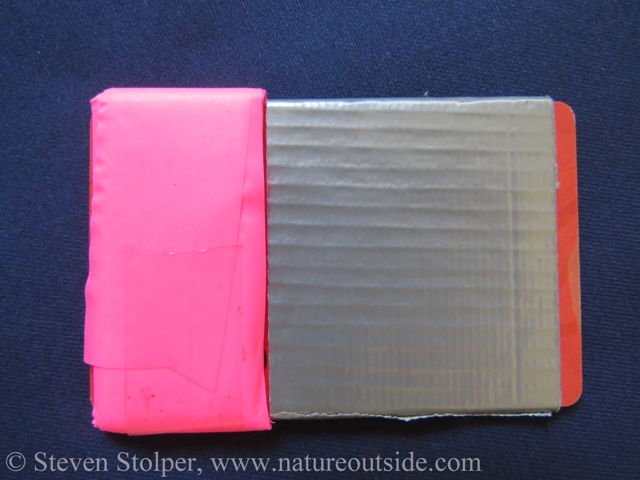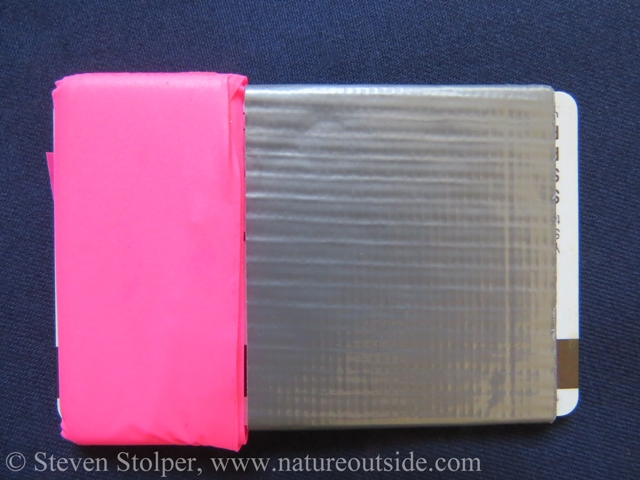Feeling My Way in the Dark
I shuffled downhill in the darkness. When I departed the dirt access road a meager patch of night sky provided some contrast to my surroundings. But once in the forest it was 50 shades of black. Giant redwood trees I could sense more than see blotted out the sky.
I strained to compensate for my blindness. Redwood needles crunched underfoot as I felt my way downward along the trail. The air was humid but not heavily so. It had the familiar aromas of the redwood forest: moss, ferns, pine needles and decomposing humus. The melody of a stream, spilling and gurgling over small boulders provided a clear point of reference. If the trail continued in its current direction, it would soon intersect the stream. I knew there should be a bridge to see me safely to the other side.
My left shoulder began to tire. Across it was the strap holding the large duffel bag containing my tent, sleeping bag, sleeping pad, and clothing. The daypack slung over my other shoulder contained my food, water, and hiking gear.
I could hear indistinct voices above the murmuring of the stream. They seemed to come from high above the far bank, downstream.
It was too dark. It was unsafe. I needed to see where the trail met the bridge. I fished my headlamp out of a cargo pocket and switched it on.
Directly ahead was the bridge. Its rigid metal frame supported a walkway made of long planks laid lengthwise across the stream. Crossing the bridge, the trail climbed the far bank and turned downstream. I followed the trail and was greeted by the smoky smell of a slow burning campfire as I coasted into camp.
A Universal Tool
I was a late arrival at the camp; at least 20 other students in the naturalist class had already pitched their tents. Eventually I found a vacant area sandwiched between teenage Douglass fir and Tanoak trees. As I pitched my tent in the darkness, one of the students approached.
Steve, I tore my sleeping bag and the insulation is coming out. Do you have any duct tape? I asked around and no one has any.
My head snapped up from where I was kneeling over my un-pitched tent. Nobody has duct tape? I was genuinely surprised. Many of the students had a great deal more dirt time than I had. Some worked professionally doing scientific research in the field for long stretches. Surely one of them would carry duct tape.
Duct tape, that wide silver cloth tape with its sticky adhesive backing is an invaluable material to carry in the outdoors. It saw use during World War II, but entered widespread civilian use commercially during the 1970s to seal leaks in ventilation and heating ducts.
Duct tape’s incredible utility has led people to use it for an astounding number of purposes. It has been used to hold just about anything and everything together. There is even a creative subculture that employs duct tape to construct everything from wallets to prom dresses.
Duct Tape and Self Reliance in the Outdoors
Implicit in bushcraft is the idea of self reliance in the outdoors. Bushcraft skills allow you to venture with confidence into our planet’s wild places. Knowledge of how to work with your natural environment provides backup to the shelter, fire, water, and food you carry in your pack.
A key tenet of bushcraft is, the more you know the less you carry. You can safely journey into the outdoors carrying less equipment if you have a practical working knowledge of the natural world and the experience, creativity, and technique to use it.
An important corollary is that knowledge and a useful general purpose tool can replace many specialized ones. This is an alluring concept to those of us who do multi-day trips in the outdoors carrying our equipment on our backs. A single general purpose tool may not do a particular job as well as a specialized one. But the weight of carrying many specialized tools is simply impractical.
Duct tape is one of these amazing general purpose tools. I can splint a broken arm using duct tape and thin sticks. I can tape a loop of cord to a water bottle to lower it into a gorge to collect drinking water from a stream. I can fix a broken tent pole, remove a splinter, and even repair a cracked water bottle. Duct tape, light weight and versatile, helps address the myriad “unknown unknowns” (large and small) that can plague on an outdoor trip. If Murphy were an outdoorsman, he would have been pleased with duct tape.
Duct tape is one general purpose item I recommend everyone carry with them in the outdoors.
Don’t Leave Home Without It
How should you carry duct tape? How much should you have? There are no set answers to these questions.
When my fellow student asked me for duct tape, I quickly reached into my daypack. Inside my pack’s hydration sleeve, I carry my survival gear and first aid kit. My survival gear is stored in a tough airtight-watertight plastic bag. Opening this bag, I grabbed… my supermarket discount card!
I have an old supermarket discount card for which I never filled out the application. As a result, there is no personal information associated with the card’s magnetic strip. The disused card makes a great platform for carrying tapes of all kind. I keep the card inside a small ziplock bag to limit oxygen exposure and reduce abrasion to the surface of the tape.
Below is a picture of the card. Wrapped tightly around the card is my duct tape. I also have surveyor’s tape wrapped around the card.

Duct tape and Surveyor’s tape wrapped around discount card

Make sure no personal information is written on the card or coded on its magnetic strip
The card measures 2 inches on a side. So wrapping the tape around the card 10 times gives me more than 3 feet of duct tape. The tape has been on the card for about 10 years and still retains its tackiness. My classmate was able to unwind the length he needed and easily rip it from the card.
Despite the pictures above, the end of the duct tape should be against a “long” side of the card to help it stay on. My classmate must have ripped the tape using the edge of the card to assist him. So the edge of the tape is at the edge of the card. I will fix this when I get a moment.
There are other means for carrying duct tape. You can purchase “flat” duct tape in rectangular strips. But it is relatively expensive and limits your choice as to the amount of tape you carry. You can also wrap the tape around water bottles and other equipment. I do not use this approach because the tape takes a beating and is exposed to the elements. It might not be good when I need it.
I much prefer using an old discount card or one of those fake credit cards included in bulk mail advertising. Be careful not to use a card that has personal information written on it, or encoded on its magnetic strip.
I also carry surveyor’s tape wrapped around the card. You find this plastic tape streaming from wooden stakes around construction sites. Its eye-catching colors can be used to mark a point of reference if you get lost, or attract the attention of rescuers to a natural shelter. Surveyor’s tape is a non-adhesive plastic strip. So after wrapping it, I use scotch tape to secure the free end.
Share your thoughts
Do you have any “essential” tools you think everyone should carry in the outdoors? I would love to hear about them in the comments below.
Related Articles on NatureOutside
Bushcraft Knife Safety – 9 Tips to Avoid Accidents
My most popular first aid supply of the year! (2015)
Maxpedition Individual First Aid Pouch
For fun facts and useful tips, join the free Bushcraft Newsletter.



Duct-tape has capabilities which are hard to replicate out of natural resources without investing a lot of work, so it is indeed a good idea to always take it on trips (it is lightweight, no reason to leave it at home).
Great website btw!
Ruud, you make an excellent point. It is hard to find natural materials that can do what duct tape does. It is versatile and saves time and calories we would spend trying to improvise a substitute.
Put an acute notch in one edge of the card, and you have a tick remover.
TAHAWK, this is an interesting idea.
You could sharpen one edge so you can use the cards to scrape or to remove stuff out of a smooth surface.
I like this article, maybe you could do one about bicycle inner tubes. Like duck tape, there is many many uses for inner tubes in outdoors activities, cut into rings, stripes, or the whole thing, even to use it as kindling to start a fire.
Juan, this is a creative idea I never heard before. Very interesting!
You make a good point about inner tubes (“Ranger bands”). Here is a link to another post where I use one to modify a knife sheath so it can carry a firesteel (https://www.natureoutside.com/fallkniven-f1-knife-review/). I will certainly look at writing about Ranger bands in a future post.
Search mythbusters, duct tape island. Enough said. Stay safe out there folks.
Thanks, Cole! I will have to check out that episode. It looks epic!
I carry some rolled around a pencil cut to the as wide as the tape
Frank, I like this idea! I like that you can make wood shavings from the pencil as tinder, or use the entire thing as… a pencil!
I’ve seen YouTube prepping videos with people using large chubby pencils to store duct tape.
Alternatively, if you don’t have an old plastic store card lying around (due to my relatively young age, I don’t have any spare store cards at the moment lol), you may be able to buy bits of plastic of a similar size and shape off EBay? Or you could get a piece of cardboard etc. then laminate it or tape it to make it stronger and wrap tape around that.
Finally, one YouTube prepping video I saw involved the use of a coffee plastic stirrer that you get in coffee machines in shops for the storage of each kind of EDC tape.
~Pragmatic Prepper
Emma – Thank you for your comment! I like each of these ideas, but the one I like best is the pencil. If you ever need dry tinder in an emergency, you can slice wood shavings from the pencil with your knife. Plus it still works as a pencil!
I learned from backpackers in the Appalachian trail. Wrap a foot of duct tape around the top of your hiking poles, then there’s no added weight in your pack.
Gena, I have seen this too. I have also seen many backpackers wrap tape around the outside of their water bottles. The drawback of these two approaches is that the tape is exposed to the elements. Eventually the tape degrades from exposure to sunlight, dirt/dust, and weather.
thanks for the great article, keep up the good work
Thank you, Zidane!